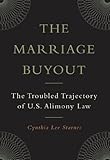The Marriage Buyout : The Troubled Trajectory of U.S. Alimony Law / Cynthia Lee Starnes.
Material type: TextSeries: Families, Law, and Society ; 4Publisher: New York, NY : New York University Press, [2014]Copyright date: ©2014Description: 1 online resourceContent type:
TextSeries: Families, Law, and Society ; 4Publisher: New York, NY : New York University Press, [2014]Copyright date: ©2014Description: 1 online resourceContent type: - 9780814708248
- 9780814708477
- 346.7301663
- online - DeGruyter
| Item type | Current library | Call number | URL | Status | Notes | Barcode | |
|---|---|---|---|---|---|---|---|
 eBook
eBook
|
Biblioteca "Angelicum" Pont. Univ. S.Tommaso d'Aquino Nuvola online | online - DeGruyter (Browse shelf(Opens below)) | Online access | Not for loan (Accesso limitato) | Accesso per gli utenti autorizzati / Access for authorized users | (dgr)9780814708477 |
Browsing Biblioteca "Angelicum" Pont. Univ. S.Tommaso d'Aquino shelves, Shelving location: Nuvola online Close shelf browser (Hides shelf browser)

|

|

|

|

|

|

|
||
| online - DeGruyter Legal Pluralism and Empires, 1500-1850 / | online - DeGruyter The Fervent Embrace : Liberal Protestants, Evangelicals, and Israel / | online - DeGruyter Staging Faith : Religion and African American Theater from the Harlem Renaissance to World War II / | online - DeGruyter The Marriage Buyout : The Troubled Trajectory of U.S. Alimony Law / | online - DeGruyter Keywords for American Cultural Studies, Second Edition / | online - DeGruyter Sex without Consent : Rape and Sexual Coercion in America / | online - DeGruyter American Behavioral History : An Introduction / |
Frontmatter -- Contents -- Acknowledgments -- Introduction -- Part I. Alimony reflections -- 1. Who cares about alimony? -- 2. Alimony’s heritage: the helpless, the blameless, and the clean-break losers -- 3. Alimony and mother myths -- Part II. Alimony mechanics -- 4. The contemporary state of alimony -- 5. Alimony in context: a comparative perspective -- Part III. Alimony theory -- 6. Reasons matter alimony, intuition, and the remarriage-termination rule -- 7. The search for a contemporary rationale -- Part IV. Alimony reform -- 8. A marital partnership model: alimony as buyout -- 9. Beyond alimony: lovers, parents, and partners -- Conclusion -- Notes -- Index -- About the author
restricted access online access with authorization star
http://purl.org/coar/access_right/c_16ec
From divorce court to popular culture, alimonyis a dirty word. Unpopular and rarely ordered, the awards are frequentlyinconsistent and unpredictable. The institution itself is often viewed as anhistorical relic that harkens back to a gendered past in which women lacked theeconomic independence to free themselves from economic support by their spouses.In short, critics of alimony claim it has no place in contemporary visions ofmarriage as a partnership of equals. But as Cynthia Lee Starnes argues in TheMarriage Buyout, alimony is often the only practical tool for ensuring that divorce does not treattoday’s primary caregivers as if they were suckers. Her solution is toradically reconceptualize alimony as a marriage buyout.Starnes’s buyouts draw on a partnership model of marriage that reinforcescommunal norms of marriage, providing a gender-neutral alternative to alimonythat assumes equality in spousal contribution, responsibility, and right. Herquantification formulae support new default rules that make buyouts morecertain and predictable than their current alimony counterparts. Looking beyondalimony, Starnes outlines a new vision of marriages with children, describing aco-parenting partnership between committed couples, and the conceptual basisfor income sharing between divorced parents of minor children. Ultimately,under a partnership model, the focus of alimony is on gain rather than loss andequality rather than power: a spouse with disparately low earnings isn’t asucker or a victim dependent on a fixed alimony payment, but rather an equalstakeholder in marriage who is entitled at divorce to share any gains themarriage produced.
Mode of access: Internet via World Wide Web.
In English.
Description based on online resource; title from PDF title page (publisher's Web site, viewed 06. Mrz 2024)


